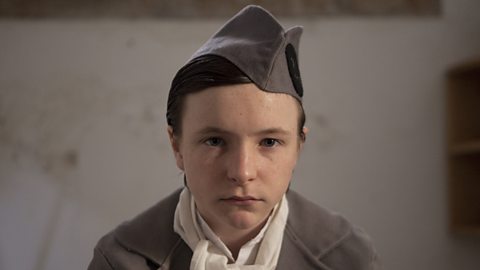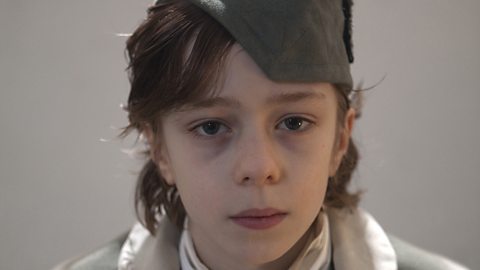Video summary
Jane Angus, aged 12, tells us how she was caught stealing and sent to a residential school where young criminals were taught a trade to stop them re-offending.
She was sentenced to 10 days in prison, and then sent to a reformatory school for five years. These strict residential schools were meant to teach young criminals a trade to stop them re-offending.
After spending five years at the reformatory, Jane got a job as a French polisher, but then she contracted tuberculosis - known in Victorian times as consumption. Jane died in 1879 aged just 17.
Note that this film includes a reference to the symptoms of consumption (tuberculosis) which may be upsetting for some KS2 and KS3 pupils. Teacher viewing is recommended prior to showing the film in class.
Teacher Notes
Questions to consider whilst watching the film
Depending on the focus of your lesson, you may wish to ask the following questions after the video or the pause the short film at certain points to check for understanding.
- Why do you think Jane was stealing?
- What was the purpose of the reformatory school?
- Why was a typical day at the school so strictly timetabled?
- What impact do you think poverty had on the amount of crime in Victorian times?
- Do you think the length of the sentence was fair in comparison to the offence?
- What impact do you think the time spent in reformatory school had on the Jane's health?
Learning activities to explore after the video
History is a subject which can lend itself to a wide range of cross-curricular links. As a teacher, you will have a greater awareness of how this topic may act as stimulus for learning in other subjects. However, the suggestions below relate solely to ways of developing the children’s historical knowledge and understanding.
Key Question: What were the differing attitudes to boy and girl criminals?
Concept of similarity and differenceIt is important in history to encourage pupils not to make assumptions that life was the same for all Victorians. In particular life would be different depending on whether you were boy or a girl. A good initial stimulus to generate debate is this extract from the poem The Princess, written by Alfred Tennyson in 1847.
“Man for the field and woman for the hearth:Man for the sword and for the needle she:Man with the head and woman with the heart:Man to command and woman to obey;”
To be fair to Tennyson, he is mocking these views as his poem tells the story of a princess who rebels against the patriarchal society, establishing a university where only women are allowed to enter. However, the views in those four lines were commonly held at the time poem was written.
It was these sexist views which explain the different treatment of boy and girl criminals, which is explored in the video. The pupils could learn about the separate reformatory schools for boys and girls as a case study of gender roles in Victorian society. Ideally the class would focus on local examples and it may be that your local library or museum has suitable resources. However, if that is not the case, it is possible to use web-based sources.
contains information and some photographs of the Leeds Reformatory School for Boys. This serves an interesting comparison to the reformatory school for girls which Jane Angus was sent to. This theme could be explored further on the website as it has separate information for the both the Leeds Industrial School for Boys and for Girls. Although industrial schools was the focus for this 91Čȱ¬ Teach video, these could be incorporated into a study of gender differences.
There is an opportunity in organising this lesson to promote . The class could be divided into groups of four and each individual could either be tasked with researching different aspects or, depending on time constraints, be provided with different information. The focus for each individual could be divided like this:1: Boys Schools: School Facilities2: Boys Schools: Curriculum3: Girls Schools: School Facilities 4: Girls Schools: Curriculum
EmpathyHistory can be more meaningful for pupils if rather than a generalised study of a topic, the same subject is explored by focusing on real people. The power of the particular can be used to develop pupils’ empathy for others. In history, when developing empathy with pupils, it is essential that the pupils have access to historical information. If not, the danger is the exercise does not develop historical thinking but is a creative and imaginative exercise, though this would be valid in other curricula areas.
, utilised above, has two case studies of Annie Hornby and Albert Taylor and although they were admitted to their schools in 1909 and 1910 respectively, which is outside the Victorian period, it contains the sort of historical information needed for true historical empathy. The class could work in pairs with each child given the admission record for either Annie or Albert. Ideally, the children would look at the original record as it is possible to read the handwriting, though it may be more effective if the information were transcribed or studied as a class before the empathy exercise. This may be as an improvised dialogue between Annie and Albert, talking about their families and why they were arrested. A teacher would need to exercise caution with this activity as both Annie and Albert suffered from parental neglect
The 91Čȱ¬ is not responsible for any of the content in the above external links.
Learning aims or objectives
England
From the History National CurriculumPupils should:
- understand historical concepts such as similarity, difference.
- understand the methods of historical enquiry, including how evidence is used rigorously to make historical claims.
Northern Ireland
From the statutory requirements for Key Stage 2 - The World Around Us
Pupils should be enabled to explore:
- Change over time in places.To provide a balance of experiences in history pupils could study:
- Some of the characteristics of past societies and distinctive features of life in the past.Teaching should provide opportunities for children as they move through Key Stages 1 and 2 to progress:
- from identifying similarities and differences to investigating similarities and differences, patterns and change.
Scotland
From the Experiences and Outcomes for planning learning, teaching and assessment ofSecond Level Social Studies:
- I can use primary and secondary sources selectively to research events in the past.
- I can compare and contrast a society in the past with my own and contribute to a discussion of the similarities and differences.
Wales
From the new Humanities Area of Learning and Experience
School curriculum design for history should:
- develop historical … source-based skills.
- develop rich content across the time periods, through which learners can develop an understanding of chronology through exploring … change and continuity…the use of evidence.
Principles of progressionDescriptions of learning for Progression Step 2
Enquiry, exploration and investigation inspire curiosity about the world, its past, present and future:
- I have experienced a range of stimuli, and had opportunities to participate in enquiries, both collaboratively and with growing independence.
- I can collect and record information and data from given sources. I can then sort and group my findings using different criteria.
Human societies are complex and diverse, and shaped by human actions and beliefs:
- I can recognise similarities and differences between people’s lives, both in the past and present.
- I can identify aspects of life in my community that have changed over time.
How the Victorians introduced photograph police records. video
The story of young offender James Dunn Barr is used to explain how the invention of photography changed the way criminals, young and old, could be identified.

Life in prison for young Victorian offenders. video
This short film explores Victorian punishments through the eyes of John, a young offender who was sent to prison for six months in January 1876.

Life at a Victorian industrial school. video
13-year-old James Fleming from Perth explains how he came to be sent to an industrial school.
